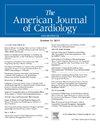IF 2.3
3区 医学
Q2 CARDIAC & CARDIOVASCULAR SYSTEMS
引用次数: 0
摘要
冠状动脉疾病(CAD)仍然是肾移植(RTx)受者发病和死亡的主要原因,非st段抬高急性冠状动脉综合征(NSTE-ACS)是不成比例的高负担。然而,RTx受者NSTE-ACS的最佳血运重建策略仍不清楚。这项回顾性研究分析了2016-2021年全国再入院数据库。RTx接受者(≥18岁)接受冠状动脉旁路移植术(CABG)或经皮冠状动脉介入治疗(PCI)治疗NSTE-ACS。主要结局是住院死亡率,同时围手术期并发症、计划外30天和90天再入院、重复血运重建术和同种异体肾移植失败也被考虑在内。使用多变量logistic回归和Royston-Parmar模型来确定血运重建方式、时间和结果的风险调整相关性。在3323名患者中,20.5%的患者接受了冠脉搭桥,79.5%的患者接受了PCI。调整后,CABG与较高的围手术期并发症相关(AOR 3.46, 95% CI 2.31-5.19),并有增加死亡风险的趋势(AOR 1.79, 95% CI 0.76-4.18)。Royston-Parmar分析显示,出院90天内再次入院或移植肾衰竭的风险无差异,但CABG与重复血运重建的风险较低相关(HR 0.24, 95%CI 0.08-0.76)。时间分析显示,两种模式的死亡率在不同时间间隔内保持稳定。虽然PCI并发症随着血管重建延迟时间的延长而增加,但CABG表现出更稳定的模式。总之,我们的研究结果表明,与冠脉搭桥相比,NSTE-ACS RTx受者的死亡率和并发症风险较低。然而,冠脉搭桥可以降低重复血运重建的风险和更大的时间灵活性,而不影响同种异体肾移植功能。本文章由计算机程序翻译,如有差异,请以英文原文为准。
Association of Coronary Revascularization Modality and Timing With Outcomes of Acute Coronary Syndrome in Kidney Transplant Recipients
Coronary artery disease (CAD) remains a leading cause of morbidity and mortality among renal transplant (RTx) recipients, with non-ST-segment-elevation acute coronary syndrome (NSTE-ACS) representing a disproportionately high burden. However, the optimal revascularization strategy for NSTE-ACS in RTx recipients remains unclear. This retrospective study analyzed the 2016 to 2021 Nationwide Readmissions Database. RTx recipients (≥18 years) undergoing coronary artery bypass grafting (CABG) or percutaneous coronary intervention (PCI) for NSTE-ACS were included. The primary outcome was in-hospital mortality, while perioperative complications, unplanned 30- and 90-day readmissions, repeat revascularization, and renal allograft failure were also considered. Multivariable logistic regression and Royston–Parmar models were used to identify the risk-adjusted association of revascularization modality, timing, and outcomes. Of an estimated 3,323 patients, 20.5% underwent CABG and 79.5% PCI. Following adjustment, CABG was associated with higher perioperative complications (AOR 3.46, 95% CI 2.31 to 5.19) and demonstrated a trend toward increased mortality risk (AOR 1.79, 95% CI 0.76 to 4.18). Royston–Parmar analysis demonstrated no difference in freedom from readmission or renal allograft failure within 90 days of discharge, but CABG was associated with a lower hazard of repeat revascularization (HR 0.24, 95% CI 0.08 to 0.76). Timing analysis revealed stable mortality rates across intervals for both modalities. While PCI complications increased with longer delays to revascularization, CABG demonstrated a more stable pattern. In conclusion, our findings suggest that PCI appears to be associated with lower risks of mortality and complications compared to CABG in RTx recipients with NSTE-ACS. However, CABG may offer benefits of reduced risk of repeat revascularization and greater flexibility in timing without compromising renal allograft function.
求助全文
通过发布文献求助,成功后即可免费获取论文全文。
去求助
来源期刊

American Journal of Cardiology
医学-心血管系统
CiteScore
4.00
自引率
3.60%
发文量
698
审稿时长
33 days
期刊介绍:
Published 24 times a year, The American Journal of Cardiology® is an independent journal designed for cardiovascular disease specialists and internists with a subspecialty in cardiology throughout the world. AJC is an independent, scientific, peer-reviewed journal of original articles that focus on the practical, clinical approach to the diagnosis and treatment of cardiovascular disease. AJC has one of the fastest acceptance to publication times in Cardiology. Features report on systemic hypertension, methodology, drugs, pacing, arrhythmia, preventive cardiology, congestive heart failure, valvular heart disease, congenital heart disease, and cardiomyopathy. Also included are editorials, readers'' comments, and symposia.
 求助内容:
求助内容: 应助结果提醒方式:
应助结果提醒方式:


